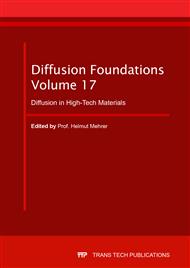p.1
p.29
p.69
p.105
p.115
Diffusion and Point Defects in Elemental Semiconductors
Abstract:
Elemental semiconductors play an important role in high-technology equipment used in industry and everyday life. The first transistors were made in the 1950ies of germanium. Later silicon took over because its electronic band-gap is larger. Nowadays, germanium is the base material mainly for γ-radiation detectors. Silicon is the most important semiconductor for the fabrication of solid-state electronic devices (memory chips, processors chips, ...) in computers, cellphones, smartphones. Silicon is also important for photovoltaic devices of energy production.Diffusion is a key process in the fabrication of semiconductor devices. This chapter deals with diffusion and point defects in silicon and germanium. It aims at making the reader familiar with the present understanding rather than painstakingly presenting all diffusion data available a good deal of which may be found in a data collection by Stolwijk and Bracht [1], in the author’s textbook [2], and in recent review papers by Bracht [3, 4]. We mainly review self-diffusion, diffusion of doping elements, oxygen diffusion, and diffusion modes of hybrid foreign elements in elemental semiconductors.Self-diffusion in elemental semiconductors is a very slow process compared to metals. One of the reasons is that the equilibrium concentrations of vacancies and self-interstitials are low. In contrast to metals, point defects in semiconductors exist in neutral and in charged states. The concentrations of charged point defects are therefore affected by doping [2 - 4].
Info:
Periodical:
Pages:
1-28
Citation:
Online since:
July 2018
Authors:
Keywords:
Price:
Сopyright:
© 2018 Trans Tech Publications Ltd. All Rights Reserved
Share:
Citation:


